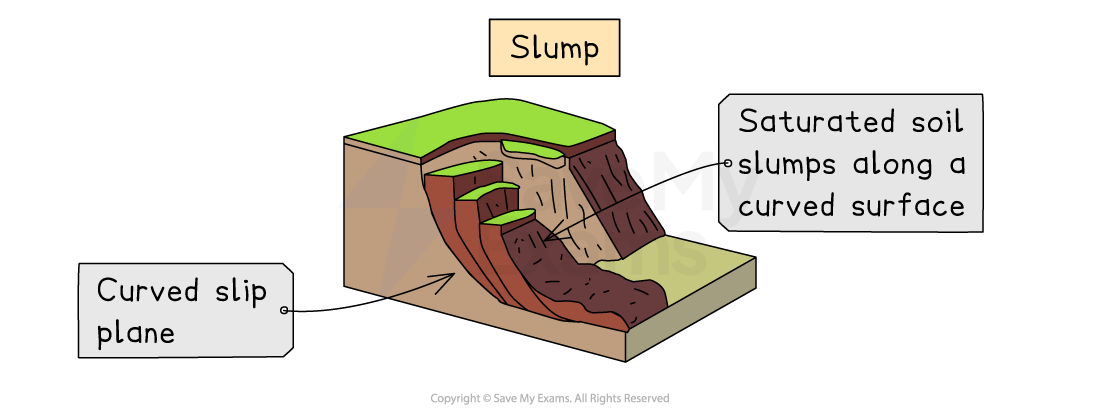River landscape processes (WJEC Eduqas GCSE Geography B): Revision Note
Exam code: C112
Specification Link
The notes on this page cover part 2.2. 1 of the WJEC Eduqas GCSE B Geography.
2.2.1 How do people and processes contribute to the development of distinctive river landscapes in the UK?
How fluvial processes, combined with weathering, mass movement and human activities, create distinctive river landscapes in the UK.
At a local scale, fluvial erosional processes to include hydraulic action, abrasion, attrition and solution. Processes of transportation and deposition include traction, saltation, suspension and solutions.
Weathering and rivers
Weathering is the breakdown of rock in the landscape around the river
There are three types of weathering
These happen in-situ
Physical
Rock is broken down into smaller pieces
This occurs due to changes in temperature, such as freeze-thaw and exfoliation

Chemical
Rocks disintegrate and dissolve in slightly acidic rainwater
Biological weathering
Rocks are broken apart by the roots of plants
Mass movement and rivers
There are several types of mass movement where large-scale movement of material occurs
In river valleys, there are two main types of mass movement:
Slumping occurs when the slope is eroded by the river.
This undercuts the slope, causing large-scale movement of material down the slope
Slumping often occurs when a softer, less resistant material overlies a harder, more resistant material

Soil creep happens when the influence of gravity causes weathered material to slowly move down the slope towards the river
Factors affecting weathering and mass movement
There are a range of factors that affect weathering and mass movement, including:
Climate: in hot, wet climates, chemical and biological weathering are dominant
Weather: heavy rainfall increases mass movement
Slope: any slope over 5° experiences mass movement
The steeper the gradient of the slope, the more mass movement there will be
Geology: different rocks have different levels of resistance to weathering
Altitude: at higher altitudes, freeze-thaw weathering occurs frequently due to the low temperatures
Aspect: physical weathering is more common on a colder, north-facing slope due to a higher likelihood of freeze-thaw
Vegetation: roots bind the soil together, which limits mass movement
Fluvial processes
Most (about 95%) of a river's energy is used to overcome friction
There is more friction in the upper course of the river
It is shallow and narrow so more water is in contact with the bed and banks
The rocks in the river are larger so more energy is used to overcome the friction to move over and around them
The rest of the river's energy is used in erosion and transportation
Energy in the river depends on the river's:
Discharge
Velocity
The greater the discharge and velocity, the more energy a river has for erosion and transportation
Erosion
Erosion is the wearing away and movement of material
There are four erosion processes that change the shape of the river channel:
Hydraulic action is when the force of the water removes material from the banks and bed of the river
Abrasion (corrasion) occurs when materials carried by the river scrape away at the banks and bed
Attrition is when the material being carried by the river hits each other; as a result, the pieces become rounder and smoother
Corrosion (solution) occurs when some rocks are dissolved by the slightly acidic water

Erosion can be mainly vertical or lateral:
Vertical erosion is dominant in the upper course of rivers
It increases the depth of the river and valley as the river erodes downwards
Lateral erosion is dominant in the middle and lower course of rivers
It increases the width of the river and valley as it erodes sideways
Transportation processes
There are four processes of transportation:
Traction occurs when larger rocks and materials are rolled along the riverbed
Saltation is when smaller material is lifted by the water and bounces along the riverbed
Suspension occurs when lighter material is carried within the river flow
Solution is when materials are dissolved in the water

Deposition
When a river does not have enough energy to carry materials, it drops them
This is deposition
The causes of reduced energy include:
Reduced discharge due to a lack of precipitation or abstraction upstream
Decreased gradient
Slower flow on the inside of a river bend
When the river enters a sea/ocean or lake
The heaviest material is deposited first; this is known as the bedload
The lighter materials, gravel, sand and silt, are known as alluvium and they are carried further downstream
The dissolved materials are carried out to sea
Examiner Tips and Tricks
It can sometimes help to remember a word and the process it refers to if you know what it means.
Traction—the action of pulling something over a surface
Saltation—leaping or jumping

Unlock more, it's free!
Did this page help you?